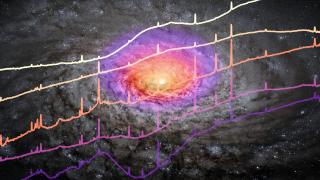Bibcode
García-González, J.; Alonso-Herrero, A.; Hönig, S. F.; Hernán-Caballero, A.; Ramos Almeida, C.; Levenson, N. A.; Roche, P. F.; González-Martín, O.; Packham, C.; Kishimoto, M.
Bibliographical reference
Monthly Notices of the Royal Astronomical Society, Volume 470, Issue 3, p.2578-2598
Advertised on:
9
2017
Citations
33
Refereed citations
31
Description
We present new calculations of the Clumpy AGN Tori in a 3D geometry
(CAT3D) clumpy torus models, which now include a more physical dust
sublimation model as well as active galactic nucleus (AGN) anisotropic
emission. These new models allow graphite grains to persist at
temperatures higher than the silicate dust sublimation temperature. This
produces stronger near-infrared emission and bluer mid-infrared (MIR)
spectral slopes. We make a statistical comparison of the CAT3D model MIR
predictions with a compilation of sub-arcsecond resolution ground-based
MIR spectroscopy of 52 nearby Seyfert galaxies (median distance of 36
Mpc) and 10 quasars. We focus on the AGN MIR spectral index
αMIR and the strength of the 9.7 μm silicate feature
SSil. As with other clumpy torus models, the new CAT3D models
do not reproduce the Seyfert galaxies with deep silicate absorption
(SSil < -1). Excluding those, we conclude that the new
CAT3D models are in better agreement with the observed
αMIR and SSil of Seyfert galaxies and
quasars. We find that Seyfert 2 are reproduced with models with low
photon escape probabilities, while the quasars and the Seyfert 1-1.5
require generally models with higher photon escape probabilities.
Quasars and Seyfert 1-1.5 tend to show steeper radial cloud
distributions and fewer clouds along an equatorial line of sight than
Seyfert 2. Introducing AGN anisotropic emission besides the more
physical dust sublimation models alleviates the problem of requiring
inverted radial cloud distributions (i.e. more clouds towards the outer
parts of the torus) to explain the MIR spectral indices of type 2
Seyferts.
Related projects

Nuclear Activity in Galaxies: a 3D Perspective from the Nucleus to the Outskirts
This project consists of two main research lines. First, the study of quasar-driven outflows in luminous and nearby obscured active galactic nuclei (AGN) and the impact that they have on their massive host galaxies (AGN feedback). To do so, we have been granted time with the Gran Telescopio CANARIAS (GTC) in the optical and near-infrared ranges
Cristina
Ramos Almeida